Construction equipment encompasses a wide range of machines used in building, mining, and infrastructure projects. Common types include excavators, bulldozers, and cranes. Visual guides with names and pictures help professionals and learners identify equipment, understand their roles, and operate them safely. These resources are essential for training and project planning.
Today is 06/26/2025 23:14:53 ()
1.1 Importance of Construction Equipment in Modern Construction
Construction equipment plays a vital role in modern construction, enabling projects to be completed efficiently, safely, and cost-effectively. These machines accelerate tasks like excavation, material handling, and paving, ensuring timelines are met. Advanced equipment improves precision, reducing errors and enhancing overall project quality. Additionally, specialized machinery like cranes and excavators allows for the construction of complex structures that were previously unimaginable. By streamlining operations, construction equipment minimizes manual labor, reduces costs, and enhances workplace safety. Its importance extends to maintaining environmental standards, as modern machines often feature eco-friendly designs. Without construction equipment, achieving the scale and complexity of today’s infrastructure would be impossible. It is indispensable for driving innovation and progress in the construction industry.
1.2 Brief History of Construction Equipment Development
The development of construction equipment dates back to ancient civilizations, where simple tools like pulleys and levers were used for lifting and moving materials. The Industrial Revolution marked a significant turning point, introducing steam-powered machinery that replaced manual labor. By the 20th century, advancements in engineering led to the creation of hydraulic systems, making equipment like excavators and cranes more efficient. The post-war era saw the rise of heavy-duty machinery, such as bulldozers and wheel loaders, which became essential for large-scale projects. Modern construction equipment now incorporates cutting-edge technology, including automation and GPS systems, to enhance precision and productivity. This evolution reflects human ingenuity and the constant need for better tools to build and shape the world. The history of construction equipment is a testament to innovation and progress.
1.3 Overview of Common Construction Equipment Types
Construction equipment is categorized into various types based on their functions. Earthmoving equipment, such as bulldozers, excavators, and wheel loaders, is used for digging, moving soil, and handling materials. Material handling equipment includes cranes, forklifts, and hoists, which are essential for lifting and transporting heavy loads. Concrete and asphalt equipment, like mixers, pavers, and pumps, are specialized for road and pavement construction. Aerial lift equipment, including scissor lifts and boom lifts, facilitates work at heights, while road construction equipment such as rollers and pavers ensure smooth surface finishes. Utility and support equipment, like generators and air compressors, provide power and energy for site operations. Specialized heavy-duty equipment, such as tunnel boring machines and draglines, is used for large-scale projects. Each type of equipment plays a crucial role in modern construction, ensuring efficiency and safety on-site.
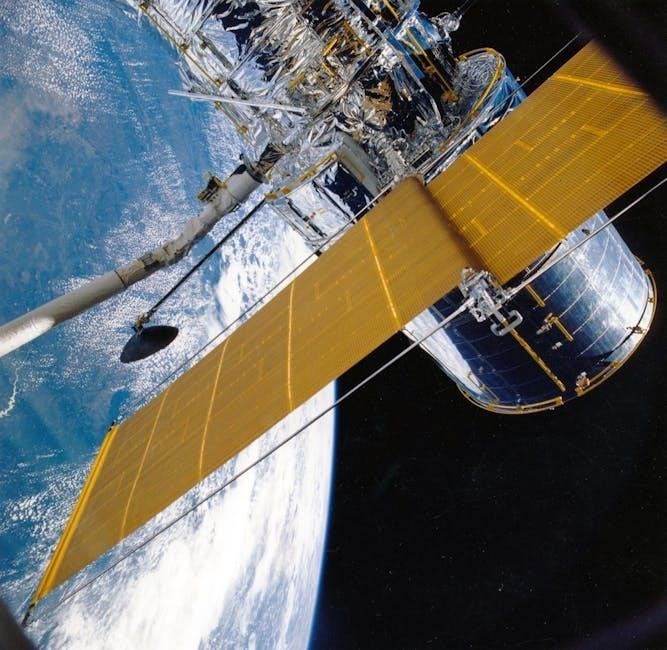
Earthmoving Equipment
Earthmoving equipment includes bulldozers, excavators, wheel loaders, and backhoes. These machines are used for digging, moving soil, and preparing terrain for construction projects.
2.1 Bulldozers: Types, Features, and Applications
Bulldozers are robust earthmoving machines used for pushing large quantities of soil, sand, and debris. They are categorized into crawler and wheeled types, each suited for different terrains. Crawler bulldozers, with continuous tracks, provide superior traction on soft or uneven ground, while wheeled bulldozers offer mobility and speed on hard surfaces. Key features include a sturdy blade, powerful engines, and hydraulic systems for precise control. Bulldozers are essential in construction, mining, and agriculture for land clearing, grading, and road construction. Their versatility makes them indispensable in large-scale projects, enabling efficient site preparation and material movement.
- Types: Crawler and wheeled bulldozers.
- Features: Blades (straight, angled, universal), hydraulic controls.
- Applications: Land clearing, soil excavation, road building.
2.2 Excavators: Uses, Sizes, and Attachments
Excavators are versatile machines used for digging, trenching, and material handling in construction and mining. They consist of a boom, stick, and bucket, with crawler or wheeled undercarriages. Available in various sizes, from compact mini-excavators to large heavy-duty models, they cater to different project requirements. Attachments like hydraulic hammers, grapples, and tiltrotators enhance their functionality. Common uses include digging foundations, demolishing structures, and moving materials. Proper sizing and attachment selection are crucial for efficiency and safety, making excavators indispensable in modern construction.
- Sizes: Mini, medium, and large excavators.
- Attachments: Buckets, breakers, grapples, and tiltrotators.
- Applications: Digging, trenching, demolition, and material handling.
2.3 Wheel Loaders: Functionality and Maintenance Tips
Wheel loaders are highly versatile machines used for loading materials like soil, sand, and debris into trucks or stockpiling them. They feature a front-mounted bucket and articulated steering for maneuverability. Common applications include construction sites, quarries, and agricultural settings. Proper maintenance is crucial for optimal performance and longevity. Regular checks include inspecting hydraulic systems, lubricating pivot points, and ensuring tire pressure is correct. Operators should also clean the bucket and attachments daily to prevent material buildup. Scheduling routine servicing with certified technicians ensures all components function efficiently, reducing downtime and extending equipment life.
- Functionality: Material loading, earthmoving, and stockpiling.
- Maintenance Tips: Hydraulic system checks, lubrication, and tire inspections.
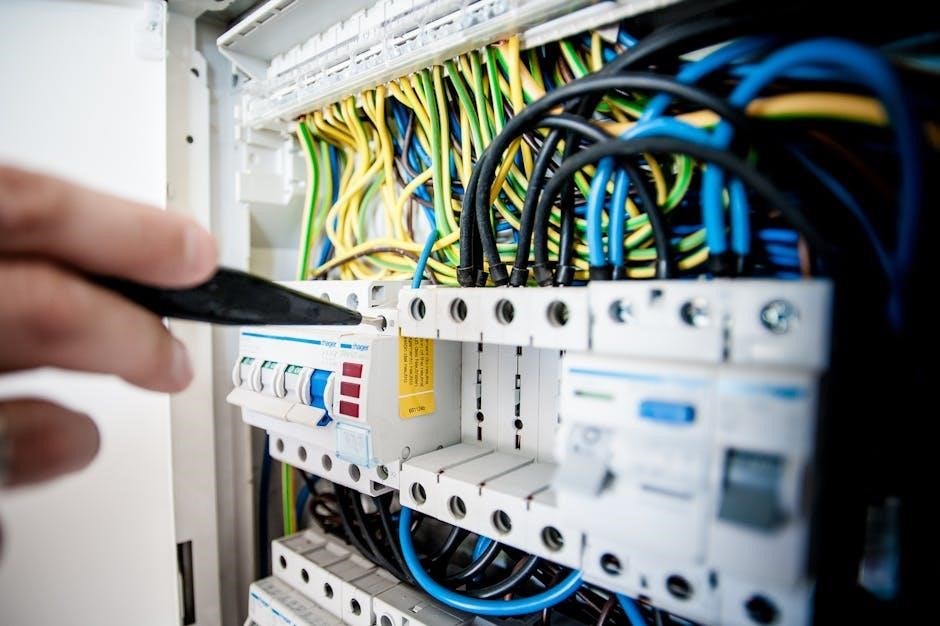
Material Handling Equipment
Material handling equipment, like cranes, forklifts, and hoists, is essential for lifting, moving, and storing materials efficiently on construction sites. These machines enhance productivity and safety.
3.1 Cranes: Types, Safety Measures, and Operation
Cranes are essential for lifting and moving heavy materials on construction sites. Common types include tower cranes, mobile cranes, and overhead cranes. Each type has specific applications, such as high-rise building construction or industrial lifting. Safety measures are critical, including proper operator training, regular equipment maintenance, and adherence to load limits. Operators must ensure the crane is level and stable before use. Additionally, proper signaling and communication with ground crews are vital to prevent accidents. Visual guides, such as those found in construction equipment PDFs, provide detailed diagrams and names of crane components, aiding in operation and maintenance. Understanding crane functionality and safety protocols ensures efficient and secure material handling in construction projects.
3.2 Forklifts: Load Capacity, Safety, and Maintenance
Forklifts are versatile machines used for lifting and transporting materials in construction and industrial settings. Load capacity varies, ranging from small electric models to heavy-duty diesel-powered units. Safety is paramount, requiring operators to undergo proper training and ensure loads are securely stabilized. Pre-operational checks, such as inspecting brakes and tires, are essential. Regular maintenance, including battery care and hydraulic system checks, ensures optimal performance. Operators must also adhere to site-specific safety protocols to minimize accidents. Visual guides in construction equipment PDFs often include labeled diagrams of forklift parts and safety symbols, aiding in operator education and compliance with industry standards. Proper usage and upkeep are critical for efficient and safe material handling.
3.3 Hoists and Winches: Applications and Safety Guidelines
Hoists and winches are integral to construction for lifting and moving heavy loads. Hoists are typically used for vertical lifting, while winches handle horizontal or inclined pulls. Applications include rigging, material lifting, and rescue operations. Safety guidelines emphasize proper load calculation, secure anchoring, and regular equipment inspection. Operators must wear personal protective gear and ensure load stability to prevent accidents. Overloading and improper maintenance are common hazards. Visual guides in construction equipment PDFs often detail hoist and winch components, correct rigging techniques, and emergency protocols. Adhering to these standards ensures efficient and safe operations, minimizing risks on construction sites. Proper training and equipment upkeep are essential for maximizing productivity and safety.
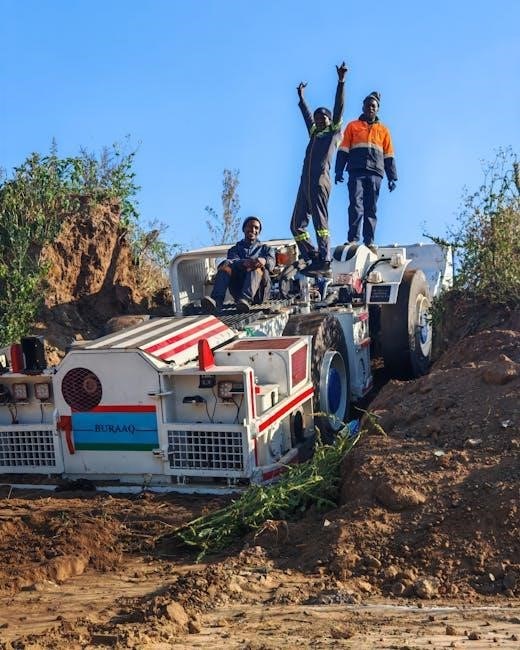
Concrete and Asphalt Equipment
Concrete and asphalt equipment includes mixers, pavers, and pumps, essential for road and building construction. These machines ensure proper mixing, laying, and setting of materials for durability and safety.
4.1 Concrete Mixers: Batch Plants and Continuous Mixers
Concrete mixers are essential for blending cement, water, and aggregates to create uniform concrete. Batch plants mix fixed quantities, while continuous mixers produce a steady flow. Both types are critical for construction projects, ensuring consistent material quality. Batch plants are ideal for large-scale operations, offering precise control over mix ratios. Continuous mixers, however, are better suited for smaller, mobile applications. Proper maintenance, including regular cleaning and lubrication, is vital for optimal performance. Safety measures, such as emergency stop systems and protective guards, are also crucial to prevent accidents. Visual guides and equipment manuals provide detailed insights, helping operators understand functionality and safety protocols. These machines are indispensable in modern construction, enabling efficient and durable concrete production.
4.2 Asphalt Pavers: Features, Uses, and Maintenance
Asphalt pavers are specialized machines used to lay and compact asphalt layers in road construction. They feature a hopper for material storage, a screed for spreading, and a tamper for compaction. These machines are essential for creating smooth, durable road surfaces. Their uses include highway construction, airport runways, and parking lots. Maintenance involves regular cleaning of the screed and hopper to prevent material buildup. Lubrication of moving parts and timely replacement of wear components, like screed plates, ensure optimal performance. Proper operation and upkeep extend the equipment’s lifespan and improve paving quality. Visual guides and manuals provide detailed maintenance schedules and operational tips, helping operators achieve professional results in various projects.
4.3 Concrete Pumps: Types, Applications, and Safety
Concrete pumps are vital for efficiently transporting and placing concrete in construction projects. They come in two main types: boom pumps, which use a robotic arm for precise placement, and line pumps, suitable for smaller projects. These pumps are widely used in high-rise buildings, bridges, and foundations. Safety measures include regular inspection of hoses and valves to prevent blockages and ensuring stable setup on firm ground. Operators must wear protective gear and follow manufacturer guidelines to avoid accidents. Proper maintenance, including cleaning and lubrication, ensures longevity. Visual guides and manuals provide detailed safety protocols and operational tips, helping to minimize risks and achieve efficient concrete placement in various construction environments.
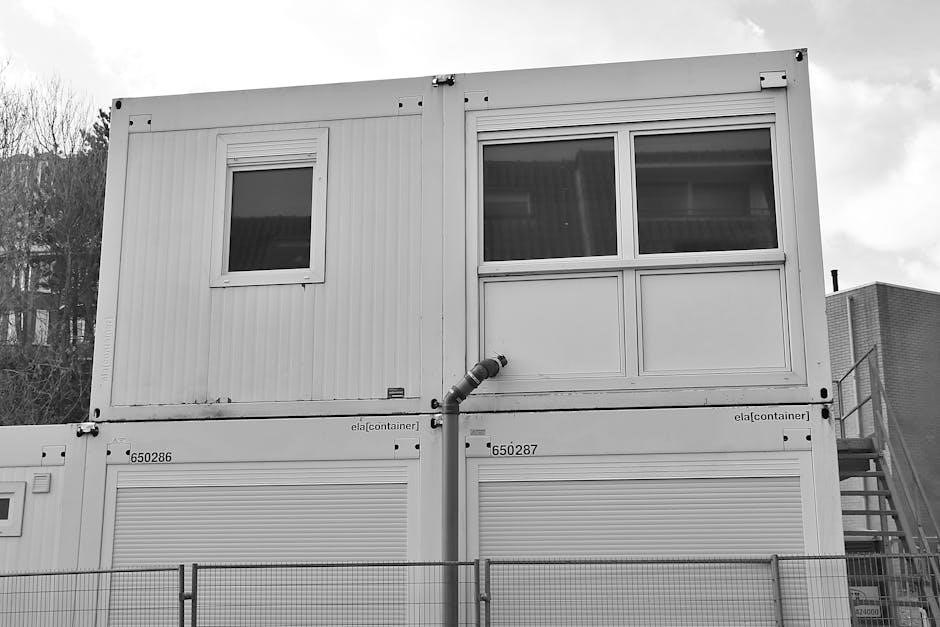
Aerial Lift Equipment
Aerial lifts are essential for elevated tasks in construction, offering safe access to high areas. Common types include scissor lifts, boom lifts, and aerial work platforms, each designed for specific tasks.
5.1 Scissor Lifts: Functionality, Safety, and Uses
Scissor lifts are versatile aerial work platforms that provide vertical lifting for tasks like maintenance, construction, and material handling. They are known for their stability and compact design, making them ideal for indoor and outdoor use. Key features include hydraulically powered lifting mechanisms and platform extensions. Safety measures are critical, as improper use can lead to accidents. Operators must undergo proper training and always wear safety harnesses. Regular maintenance, such as checking hydraulic systems and tire pressure, ensures optimal performance. Scissor lifts are widely used in industries like construction, retail, and aviation for tasks requiring elevated access. Their functionality and safety make them indispensable in modern workplaces.
5.2 Boom Lifts: Types, Maintenance, and Operation
Boom lifts are essential for reaching high areas in construction and maintenance tasks. They come in two main types: articulating (knuckle) booms, which offer flexible movement, and telescopic booms, known for their straight reach. Proper maintenance is crucial for longevity, including regular checks of hydraulic systems, tire pressure, and battery health. Operators must be trained to ensure safe operation, adhering to load limits and using safety harnesses. Boom lifts are widely used in industries like construction, utilities, and tree care. Their versatility and height capabilities make them indispensable for tasks requiring precise aerial access. Regular servicing ensures optimal performance and reduces workplace accidents, making them a reliable choice for elevated work.
5.3 Aerial Work Platforms: Safety Standards and Best Practices
Aerial work platforms (AWPs) are essential for safely accessing high areas in construction and maintenance tasks; They include boom lifts, scissor lifts, and mast lifts, each designed for specific applications. Safety standards like ANSI A92 and ISO 16368 govern their use, emphasizing operator training, equipment inspection, and load capacity adherence. Best practices include ensuring proper setup on level ground, using safety harnesses, and avoiding operation in harsh weather. Regular maintenance checks on hydraulics, stabilizers, and controls are critical. Operators must complete accredited training programs, including both theoretical and practical assessments. Employers should enforce strict safety protocols and provide emergency rescue plans. Adhering to these guidelines ensures safe and efficient operation of AWPs in various industries.
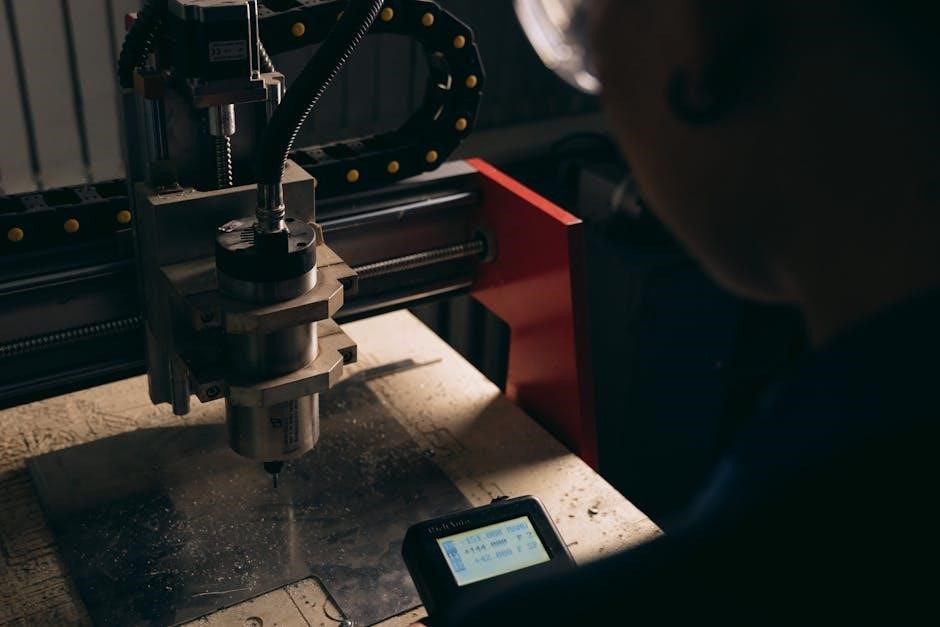
Road Construction Equipment
Road construction relies on specialized machines like road rollers, pavers, and chip spreaders. These tools ensure smooth surface preparation and material distribution for durable roads.
6.1 Road Rollers: Types, Uses, and Maintenance
Road rollers are essential for compacting surfaces in road construction. They come in types like static and vibratory rollers, each suited for different materials. Static rollers are heavy, while vibratory rollers use vibrations for deeper compaction. Regular maintenance is crucial, including lubrication and checking drum surfaces. Operators must ensure proper alignment and avoid overheating. These machines are vital for creating stable, long-lasting road foundations.
6.2 Pavers: Asphalt and Concrete Paving Machines
Pavers are specialized machines used to lay and compact asphalt or concrete for road surfaces. They are categorized into asphalt pavers and concrete pavers, each designed for specific materials. Asphalt pavers feature a hopper for material storage and a screed for spreading, while concrete pavers use a conveyor system to place and finish concrete. These machines ensure uniform thickness and smooth surfaces, critical for durability. Regular maintenance, such as lubricating moving parts and inspecting wear on screeds, is essential for optimal performance. Proper operation and upkeep extend equipment lifespan and enhance paving quality, making pavers indispensable in road construction and infrastructure development.
6.3 Chip Spreaders: Applications and Operation
Chip spreaders are specialized machines used in road construction to evenly distribute aggregate materials like gravel or chippings onto a surface. They are commonly paired with asphalt layers to create durable road surfaces. These machines feature a hopper for material storage, a spreading mechanism, and adjustable settings to control the distribution rate. Proper operation involves aligning the spreader with the road’s edge and maintaining consistent speed for uniform coverage. Regular maintenance, such as cleaning the hopper and lubricating moving parts, ensures efficiency. Chip spreaders are essential for surface dressing and road rehabilitation projects, offering cost-effective solutions for enhancing road durability and safety.
- Key applications: Road resurfacing, surface dressing, and pavement maintenance.
- Operation tips: Calibration of spreader bars and synchronization with asphalt pavers.
- Maintenance: Inspect conveyor belts and ensure proper material flow.
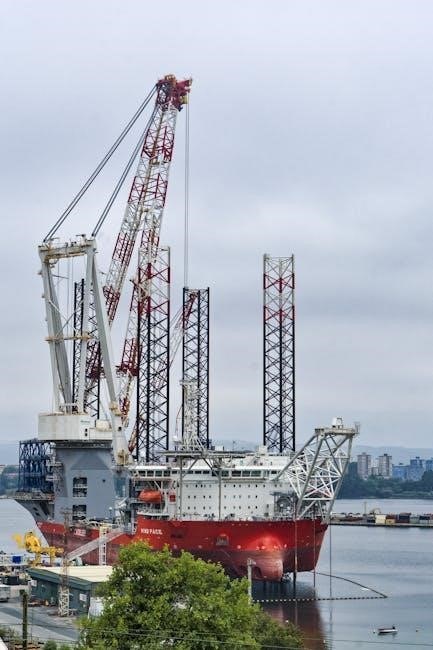
Demolition and Recycling Equipment
Demolition and recycling equipment are crucial for breaking down structures and processing materials. Machines like hydraulic hammers and crushers enable efficient recycling and project management.
7.1 Hydraulic Hammers: Uses, Maintenance, and Safety
Hydraulic hammers are versatile tools used in demolition, mining, and construction for breaking concrete, rocks, and asphalt. They are mounted on excavators and operate with high impact force. Regular maintenance is essential to ensure optimal performance and longevity. This includes lubricating moving parts, checking for wear, and replacing components as needed. Safety measures are critical, such as ensuring proper mounting and training operators to avoid accidents. Visual guides with names and pictures of hydraulic hammers can help users identify models and understand their operation. These resources are invaluable for professionals seeking to enhance efficiency and safety on-site.
7.2 Crushers: Types, Applications, and Efficiency
Crushers are essential in construction and mining for breaking down aggregates into smaller, manageable pieces. Common types include jaw crushers, cone crushers, and impact crushers, each suited for specific materials and applications. Jaw crushers excel at processing hard, abrasive materials, while cone crushers are ideal for secondary and tertiary crushing. Impact crushers are versatile and often used for recycling materials. Efficiency depends on factors like proper machine selection, regular maintenance, and optimal material flow. Visual guides with names and pictures of crushers help professionals identify models and understand their operation. Regular inspections and lubrication are critical for maintaining performance and extending equipment lifespan. Proper training ensures safe and efficient use of crushers in various projects.
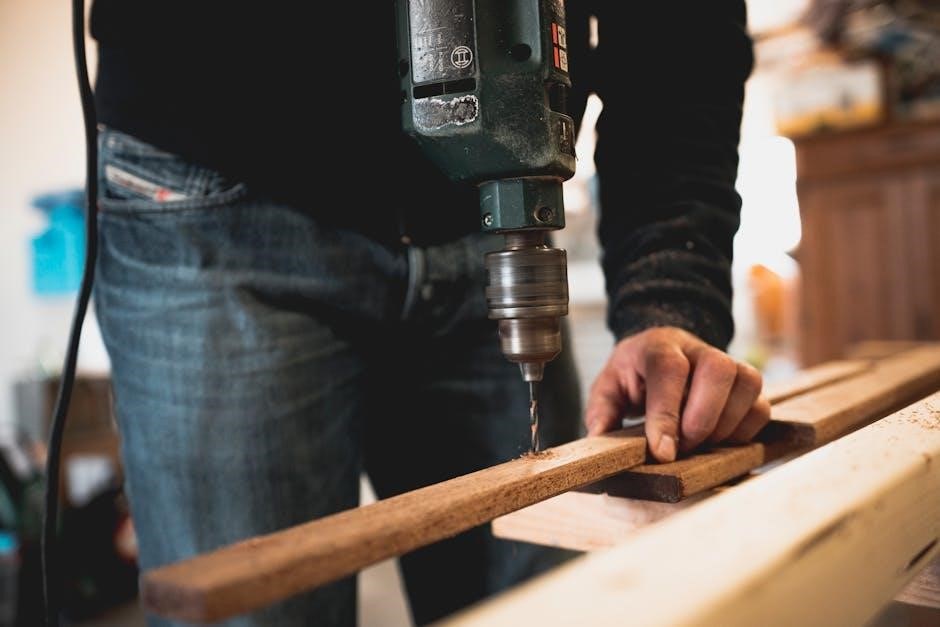
7.3 Screening Plants: Functionality and Maintenance
Screening plants are used in construction to separate materials by size, ensuring uniformity and quality in aggregates. They are crucial in recycling and mining operations. Types include vibratory screens, trommel screens, and centrifugal sifters, each designed for specific materials. Regular maintenance involves cleaning screen meshes, lubricating moving parts, and ensuring proper material flow. Visual guides with equipment names and pictures help operators identify components and perform tasks efficiently. Proper maintenance enhances longevity and productivity, reducing downtime and operational costs. Training personnel to handle screening plants safely is essential for optimal performance and workplace safety.

Utility and Support Equipment
Utility and support equipment are essential for construction sites, providing power, lighting, and compressed air. Generators, air compressors, and lighting towers ensure continuous operations, enhancing productivity and safety. Visual guides with equipment names and pictures help users identify and maintain these machines effectively.
8.1 Generators: Power Needs, Safety, and Maintenance
Generators are crucial for providing reliable power on construction sites, ensuring continuous operation of equipment. Assessing power needs is essential to select the right generator size, avoiding overload risks. Safety measures include proper installation, grounding, and regular inspection to prevent hazards like electrocution or fires. Maintenance involves checking fuel levels, oil changes, and air filters to ensure optimal performance. Visual guides, such as those in construction equipment PDFs, help identify generator types and their applications. These resources also highlight safety symbols and maintenance schedules, aiding operators in adhering to standards. Regular servicing extends equipment lifespan and ensures safe, efficient power supply for construction projects.
8.2 Air Compressors: Uses, Types, and Efficiency
Air compressors are essential in construction for powering pneumatic tools like drills, impact wrenches, and sanders. They convert electrical energy into compressed air, enabling efficient operation of equipment. Common types include rotary screw, reciprocating, and centrifugal compressors, each suited for different applications. Rotary screw compressors are known for high efficiency and continuous operation, while reciprocating models are cost-effective for smaller tasks. Ensuring proper maintenance, such as filtering air and monitoring pressure, maximizes efficiency and extends lifespan. Visual guides in construction equipment PDFs provide detailed illustrations of compressor components and operation, aiding in troubleshooting and selection. Regular servicing is critical to maintain performance and reduce energy consumption, ensuring reliable support for construction projects.
8.3 Lighting Towers: Safety, Energy Efficiency, and Setup
Lighting towers are crucial for illuminating construction sites, ensuring safety during nighttime operations. They typically feature LED floodlights for energy efficiency and durability. Setup involves stabilizing the tower with outriggers and positioning it to cover the entire work area. Safety measures include regular maintenance of lights and electrical components to prevent hazards. Energy-efficient models reduce power consumption, lowering operational costs. PDF guides with names and pictures of lighting towers help users identify the right equipment and understand proper installation. Proper setup and maintenance ensure reliable illumination, enhancing worker visibility and site safety. These resources are invaluable for contractors aiming to optimize site conditions and comply with safety standards.
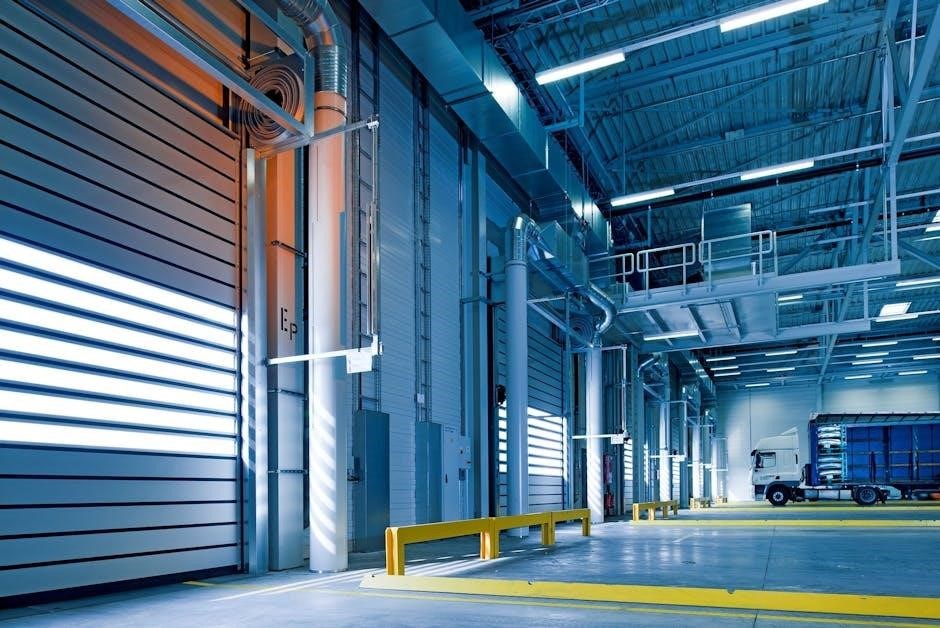
Specialized and Heavy-Duty Equipment
Specialized equipment includes tunnel borers, draglines, and pile drivers, designed for large-scale projects. These machines are highlighted in construction equipment PDF guides, showcasing their names, pictures, and uses. Energy-efficient models and safety standards are emphasized, ensuring optimal performance and worker protection.
9.1 Tunnel Boring Machines: Functionality and Applications
Tunnel Boring Machines (TBMs) are specialized heavy-duty equipment used for digging tunnels in various geological conditions. They function by rotating cutting wheels or boring heads, excavating soil or rock, and transporting debris via conveyors. Modern TBMs are categorized into types such as hard rock, soft ground, and EPB (Earth Pressure Balance) machines, each designed for specific terrains and projects.
Applications of TBMs include metro systems, highways, water supply tunnels, and mining. Their use ensures precise excavation, reduced labor costs, and enhanced safety. Safety features like laser guidance and automated systems are integral to their operation. Detailed diagrams and names of TBM components are often included in construction equipment guides, aiding engineers and operators in understanding their functionality and applications.
9.2 Pile Drivers: Types, Uses, and Maintenance
Pile drivers are heavy-duty machines used to drive piles into the ground for deep foundation construction. They are categorized into types such as impact drivers, vibratory drivers, and hydraulic drivers, each suited for specific soil conditions and project requirements. Impact drivers use a hammer to drive piles, while vibratory drivers use oscillating forces for less noise and disturbance. Hydraulic drivers offer precision and efficiency in challenging terrains.
Maintenance involves regular lubrication of moving parts, inspection of wire ropes, and replacement of worn components. Proper alignment and controlled force during operation prevent pile damage. Detailed diagrams and equipment names in construction guides help operators understand and maintain these machines effectively, ensuring longevity and safety in construction projects.
9.3 Draglines: Mining and Construction Applications
Draglines are large, heavy-duty machines used primarily in mining and construction for moving and excavating materials over long distances. They feature a long boom with a suspended bucket, ideal for deep excavations and open-pit mining. In construction, draglines are used for land reclamation, canal dredging, and large-scale excavations. Their versatility makes them essential for projects requiring extensive material movement.
Key types include walking draglines, which can move around sites, and standard draglines for stationary operations. Regular maintenance, such as boom lubrication and cable inspection, ensures optimal performance. Detailed equipment diagrams in construction guides help operators understand and utilize draglines effectively in various applications. Their efficiency and power make them indispensable in both mining and construction industries.